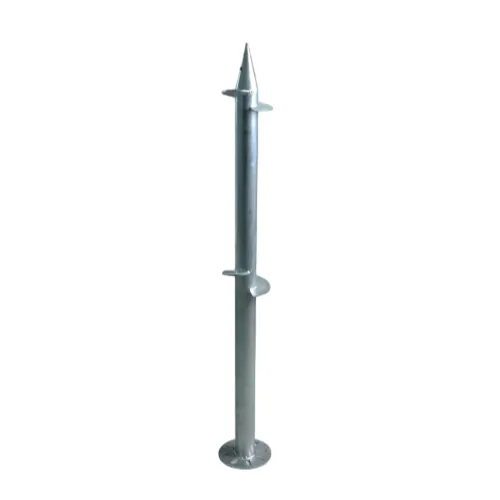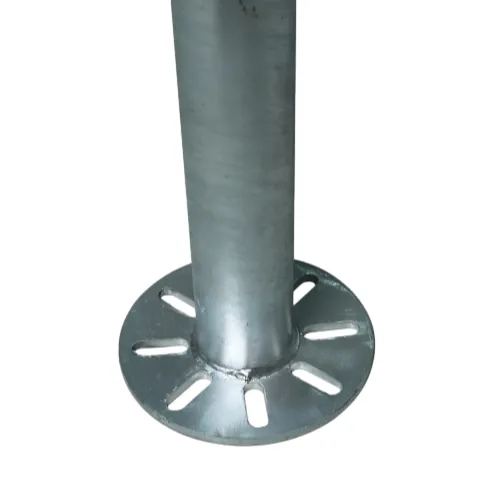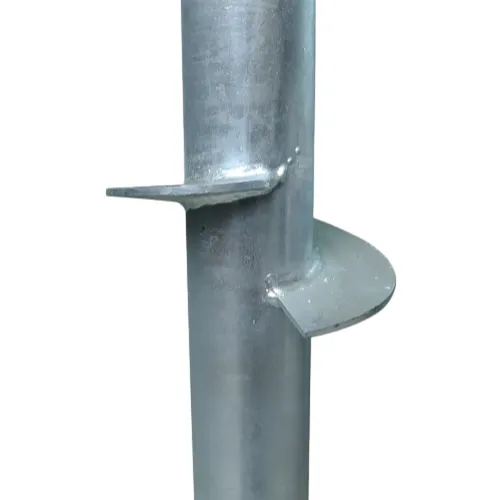
Advancing Foundations with Hot Dip Galvanized Spiral Piles
In the rapidly evolving landscape of construction and infrastructure, foundation solutions play a pivotal role in ensuring structural integrity and longevity. Among the most innovative and efficient options emerging today are spiral pile foundations. These helical piles, also known as screw piles, offer a robust alternative to traditional concrete foundations, particularly in challenging soil conditions or where minimal environmental disturbance is paramount. Unlike conventional deep foundations, a spiral pile is installed by twisting it into the ground, displacing minimal soil and providing immediate load-bearing capacity. This method significantly reduces installation time and costs, making them increasingly popular for diverse applications.
The demand for sustainable and cost-effective foundation systems is driving the adoption of solutions like spiral pile and rigid inclusion piles. While rigid inclusion piles are often used for ground improvement in soft soils by enhancing composite ground stiffness, spiral pile foundations excel in providing direct structural support with high efficiency. Their design, featuring one or more helical bearing plates affixed to a central steel shaft, allows them to be screwed into various types of piling ground, including cohesive soils, granular soils, and even rock formations. This adaptability, combined with their rapid installation and high performance, positions them as a cornerstone for modern construction projects, from residential to large-scale industrial endeavors.
Crafting Excellence: The Manufacturing Process of Hot Dip Galvanized Spiral Piles
The production of a high-quality Hot Dip Galvanized Spiral Pile For Steel Structure Foundation involves a meticulous multi-stage process, ensuring durability, strength, and superior corrosion resistance. It begins with the selection of premium-grade steel, typically conforming to standards like ASTM A500 Grade B/C or Q235/Q345, chosen for its excellent tensile strength and weldability. The raw steel undergoes precise cutting and shaping to form the central shaft and the helical flights. The helical blades are then expertly welded to the shaft using advanced robotic or manual welding techniques, ensuring robust fusion and structural integrity.

Following fabrication, the most critical step for enhanced longevity is the hot-dip galvanization process, adhering strictly to international standards such as ISO 1461. The steel assembly is thoroughly cleaned to remove impurities, then fluxed to prepare the surface for optimal zinc adhesion. It is then immersed in a bath of molten zinc at approximately 450°C (840°F). This process creates a metallurgically bonded zinc coating that provides superior barrier and cathodic protection against corrosion, significantly extending the service life of the spiral pile to 50-100 years, even in harsh environmental conditions typical for petrochemical, metallurgy, and water treatment industries. Rigorous quality control checks, including coating thickness measurement, adhesion tests, and visual inspection, ensure each pile meets stringent ISO and ANSI specifications before leaving the factory.
Technical Specifications and Performance Metrics
Understanding the technical parameters of spiral pile is crucial for engineers and project managers to ensure optimal foundation design and performance. The load-bearing capacity of a spiral pile is determined by several factors, including the soil properties, shaft diameter, the number and diameter of helical plates, and their pitch. These piles are designed to resist both compressive and tensile (uplift) forces, making them versatile for various structural loads. The table below outlines typical specifications for Hot Dip Galvanized Spiral Piles, demonstrating their robust capabilities across different applications.
| Parameter | Typical Range/Value | Significance |
|---|---|---|
| Shaft Diameter | 60mm - 219mm | Influences pile stiffness and resistance to buckling. |
| Helix Diameter | 200mm - 600mm | Crucial for load transfer to soil; larger diameter for higher capacity. |
| Number of Helices | 1 to 4+ | More helices enhance load capacity, especially in weaker soils. |
| Steel Grade | Q235, Q345, ASTM A500 Gr. B/C | Determines yield strength and structural integrity. |
| Galvanization Thickness | ≥85 microns (ISO 1461) | Directly impacts corrosion resistance and service life. |
| Ultimate Compressive Load | 30 kN - 500 kN+ | Maximum load the pile can bear in compression before failure. |
| Ultimate Tensile Load (Uplift) | 20 kN - 400 kN+ | Maximum load the pile can resist against pulling out of the ground. |
| Service Life (Galvanized) | 50 - 100+ years | Expected functional lifespan due to corrosion protection. |
These parameters are critical for geotechnical engineers in assessing soil-pile interaction and designing foundations that meet specific project requirements and safety factors. The versatility of spiral pile dimensions allows for tailored solutions across a spectrum of load demands and ground conditions.
Versatile Applications and Industry Adoption
The adaptability of Hot Dip Galvanized Spiral Piles extends their utility across an impressive array of industries and applications. Their non-disruptive installation makes them ideal for sites with sensitive environmental concerns or limited access. Common applications include foundations for solar power plants, where thousands of spiral piles can be installed rapidly to support mounting structures, significantly accelerating project timelines. Telecommunication towers, billboards, and temporary structures also benefit from their quick deployment and ease of removal, offering a reusable foundation solution.

Beyond these, spiral piles are increasingly used for residential and light commercial buildings, offering stable foundations on challenging piling ground like expansive clays or loose sands. Their use in petrochemical facilities, metallurgy plants, and municipal water treatment infrastructure highlights their reliability in demanding industrial environments where corrosion resistance is paramount. The anti-corrosion properties of hot-dip galvanization ensure these foundations withstand aggressive chemical exposures and harsh weather, leading to extended maintenance cycles and lower long-term operational costs. This broad applicability, coupled with superior performance and environmental benefits, positions spiral pile as a leading choice for modern, efficient construction practices.
Choosing the Right Partner: Manufacturer Comparison and Customization
Selecting the right manufacturer for Hot Dip Galvanized Spiral Piles is crucial for the success and longevity of any project. Key factors to consider include the manufacturer's adherence to international quality standards (ISO 9001, CE), their experience in diverse geotechnical challenges, and their commitment to research and development. A reputable manufacturer will not only provide high-quality products but also offer comprehensive technical support, including foundation design consultation and installation guidance. Their ability to provide verifiable test data, such as load tests and galvanization thickness reports, further enhances trustworthiness.

Furthermore, the capacity for customization is a significant differentiator. Projects often have unique requirements concerning soil conditions, load capacities, and structural interfaces. A leading manufacturer should offer tailor-made spiral pile solutions, adjusting shaft and helix dimensions, number of helices, and connection types to precisely match project specifications. This bespoke approach ensures optimal performance and cost-efficiency, avoiding the pitfalls of generic, one-size-fits-all solutions. Our commitment to providing precise engineering solutions backed by extensive industry experience and certified quality management systems ensures client confidence and project success.
Frequently Asked Questions (FAQ) about Spiral Piles
Q1: How does a spiral pile compare to traditional concrete foundations?
Spiral pile foundations offer several advantages, including faster installation times (no concrete curing required), minimal soil disturbance, reduced carbon footprint, and the ability to be installed in various piling ground conditions, including water-logged or frozen soils. They are also reusable, unlike concrete foundations.
Q2: What is the typical lifespan of a hot-dip galvanized spiral pile?
Thanks to the robust hot-dip galvanization process, our spiral piles boast an impressive service life of 50 to 100 years, depending on the corrosivity of the soil and environmental conditions. This extensive lifespan significantly reduces the need for maintenance or replacement, offering long-term value.
Q3: Can spiral piles be installed in all types of soil?
While spiral piles are highly versatile, their performance is optimized through proper geotechnical investigation. They perform exceptionally well in most soil types, including sands, clays, silts, and loams. In exceptionally dense or rocky ground, pre-drilling may be required. Our technical team can assess your specific piling ground conditions to recommend the ideal spiral pile solution.
Q4: What is the delivery cycle and warranty for your spiral piles?
Our standard delivery cycle for common spiral pile orders ranges from 15 to 30 days, depending on order size and customization. We provide comprehensive warranties that cover manufacturing defects and the integrity of the hot-dip galvanization, underscoring our commitment to product quality and customer satisfaction. Specific terms are provided with each quotation.

Conclusion: The Future is Built on Spiral Piles
Hot Dip Galvanized Spiral Piles represent a significant leap forward in foundation engineering, offering a blend of strength, speed, and sustainability unmatched by traditional methods. Their technical superiority, coupled with unparalleled corrosion resistance, makes them an ideal choice for a wide array of steel structure foundations across critical industrial sectors. As industries continue to seek more efficient, environmentally friendly, and cost-effective construction solutions, the role of spiral piles will only expand.
Our dedication to engineering excellence, stringent quality control, and comprehensive customer support ensures that our Hot Dip Galvanized Spiral Piles not only meet but exceed the demanding expectations of modern construction. Partner with us to lay the groundwork for your next project with a foundation that promises durability, efficiency, and long-term value.
References
- ASTM International Standards for Steel Products and Hot-Dip Galvanization.
- ISO 1461: Hot dip galvanized coatings on fabricated iron and steel articles — Specifications and test methods.
- Geotechnical Engineering Handbook, Principles of Foundation Engineering.
- Journal of Geotechnical and Geoenvironmental Engineering.
-
Wrought Iron Spears Hand Forged Scrollwork DesignNewsAug.07,2025
-
Wrought Iron Gates Hand Forged Leaf Motif CraftsmanshipNewsAug.07,2025
-
Wrought Iron Fence Panels Laurel Wreath Ornamental DetailsNewsAug.07,2025
-
Steel Rope Pulley Groove Profile Wear Resistance AnalysisNewsAug.07,2025
-
Spiral Pile Hot Dip Galvanized Anti-Corrosion TestNewsAug.07,2025
-
Ramp Door Hinge Safety Lock Mechanism DesignNewsAug.07,2025
-
Iron Leaves Ivy Vine Motif Welding TechniqueNewsAug.07,2025












